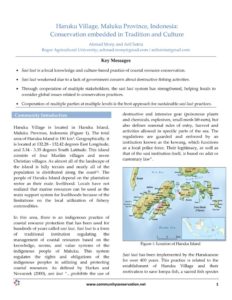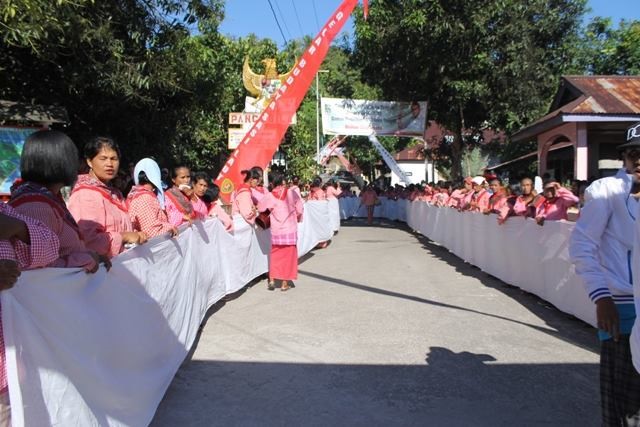
12 Jul Haruku Village, Maluku Province, Indonesia
• Sasi laut is a local knowledge and culture – based practice of coastal resource conservation.
• Sasi laut weakened due to a lack of government concern about destructive fishing activities.
• Through cooperation of multiple stakeholders,the sasi laut system has strengthened, helping locals to consider global issues related to conservation practices.
• Cooperation of multiple parties at multiple levels is the best approach for sustainable sasi laut practices
Community Introduction
Haruku Village is located in Haruku Island, Maluku Province, Indonesia (Figure 1). The total area of Haruku Island is 150 km2. Geographically, it is located at 132.28 – 132.42 degrees East Longitude, and 3.34 – 3.35 degrees South Latitude. This island consists of four Muslim villages and seven Christian villages. As almost all of the landscape of the island is hilly terrain and nearly all of the population is distributed along the coast(1). The people of Haruku Island depend on the plantation sector as their main livelihood. Locals have not realized that marine resources can be used as the main support system for livelihoods because of the limitations on the local utilization of fishery commodities.
In this area, there is an indigenous practice of coastal resource protection that has been used for hundreds of years called sasi laut. Sasi laut is a form of traditio
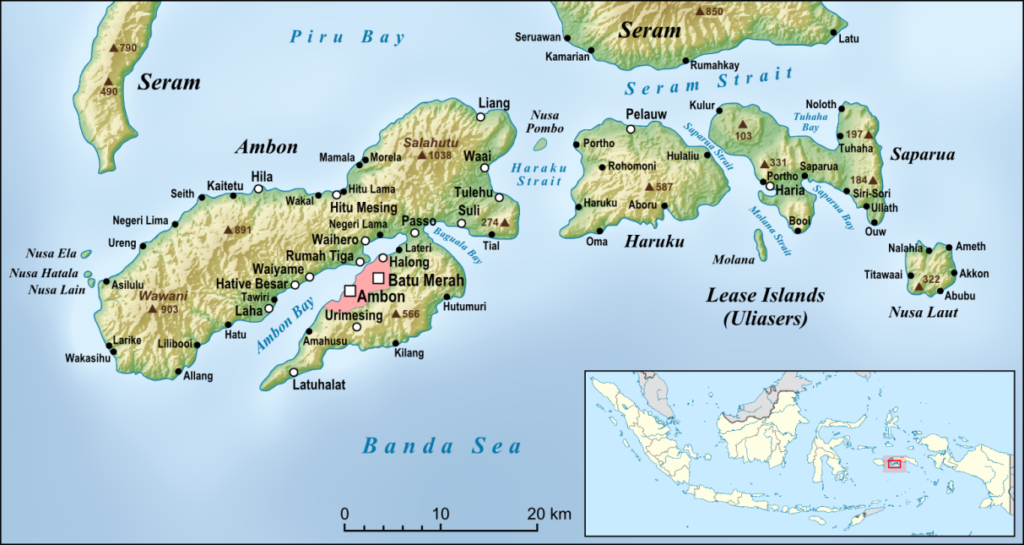
Figure 1: Location of Haruku Island
nal institution regulating the management of coastal resources based on the knowledge, norms, and value systems of the indigenous people of Maluku. This system regulates the rights and obligations of the indigenous peoples in utilizing and protecting coastal resources. As defined by Harkes and Novaczek (2000), sasi laut “…prohibits the use of destructive and intensive gear (poisonous plants and chemicals, explosives, small mesh lift-nets), but also defines seasonal rules of entry, harvest and activities allowed in specific parts of the sea. The regulations are guarded and enforced by an institution known as the kewang, which functions as a local police force. Their legitimacy, as well as that of the sasi institution itself, is based on adat or customary law”.
Sasi laut has been implemented by the Harukunese for over 400 years. This practice is related to the establishment of Haruku Village and their motivation to save lompa fish, a sacred fish species relating to the history of the formation of the village (Figure 2) (Thrissima balema)(3).
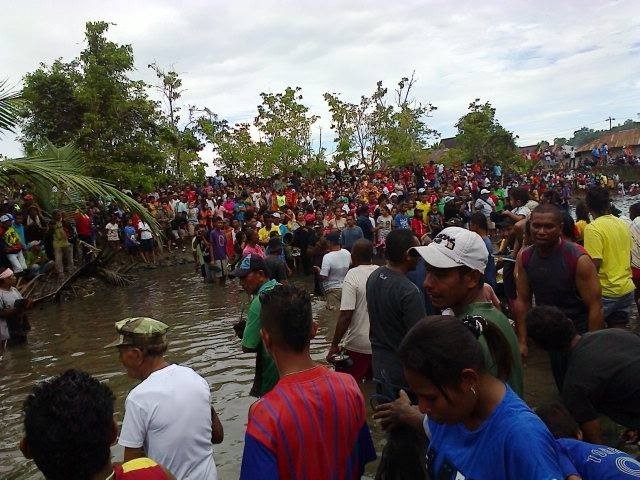
Figure 2: Harvesting Lompa Fish
Climate change in these coastal areas, which is characterized by ecological and seasonal changes, has provided an understanding for indigenous peoples about the importance of maintaining sasi laut as a local institution to protect coastal areas. Maintaining sasi laut, amidst the impacts of climate change and social transformation, will have an important impact on the preservation of coastal and inland resources, the preservation of culture, and ensuring the availability of fish in the waters.
Conservation and Livelihood Challenges
Recently, the practices of sasi laut have weakened due to the external and internal pressures of involved actors. The external factors that threatened the existence of the legal practice of sasi laut were modernization and commercialization, which resulted in the erosion of traditional values(4). In the internal level of society, sasi laut practices were faced with challenges, such as internal political conflicts, contestation of local economy, regeneration of kewang, and the power of outsiders who did not consider the social and cultural conditions of the indigenous community. In addition, locals spoke of such factors as access to fishery commodity markets, capital limitation, and lack of human resources, as the main constraints to change their orientation of livelihood income from the plantation to fishery systems (i.e., fishing/aquaculture).
The actors involved in the development of sasi laut had three main interests, i.e. economic, ecological and cultural interests. The economic interests were normally represented by communities, businesses, and local governments. The ecological interests were represented by the traditional leaders, NGOs, universities, donor agencies, environmentalists and researchers. Meanwhile, cultural interests were represented by the indigenous communities, universities, and government. This mixture of interests in the region created uncertainty about the implementation of sasi laut, as kewang were unsure of which motivations to follow, thus weakening sasi laut practices.
Community Initiative
The indigenous community of Haruku, which had been more moderate and adaptive to the issues of coastal resource management, drew on cooperation among actors to further develop sasi laut. Advocacy of relationships with outside parties aroused a new awareness to expand the scope of sasi laut, and the adaptation of new values in sasi laut gained the support of the community. Furthermore, people were actively involved in such programs as a mangrove nursery and rehabilitation of mangrove areas in the estuary of the Learisa Kayeli River, one of the lompa fish habitats. The importance of mangrove rehabilitation had been increasingly recognized after the occurrence of coastal erosion in the last few years, which directly threatens human settlements and other public infrastructure.
Practical Outcomes
Due to both external and internal pressures, changes in the political, governance, natural resources and societal livelihood systems have affected the orientation of the sasi laut management system in Maluku, resulting in some positive and negative changes:
First, there has been an increasing awareness of efforts to protect coastal areas and the natural resources therein. This awareness encouraged the emergence of the kewang, assisted by outside parties, such as NGOs and donor agencies, to widen the area protection of the sasi laut system on other resources.
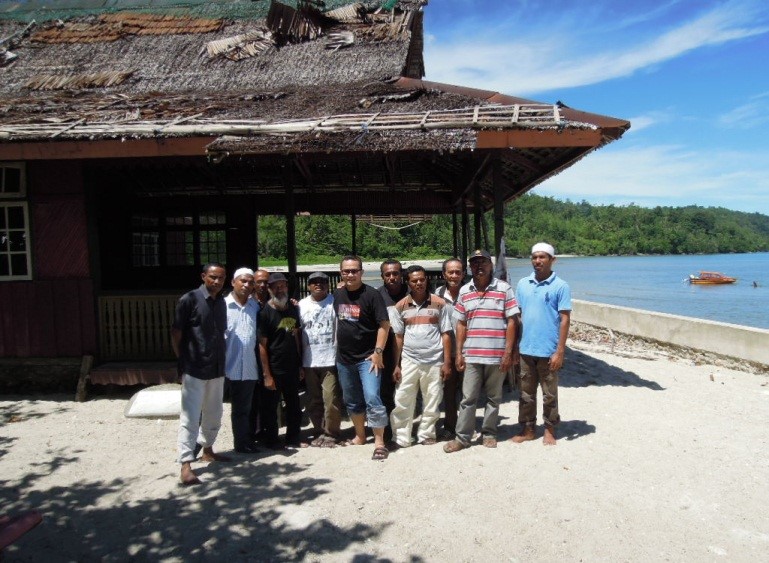
Figure 3: Village Leaders of Haruku
Second, the emergence of gender awareness has encouraged women’s involvement in the sasi laut institution. The involvement of women in the institution was based on the consideration that one of the dimensions of indigenous sasi is female, providing a certain space for the presence of women in the sasi institution pertaining to the processes of law enforcement against woman offenders on sasi.
Third, as a social institution, sasi is vulnerable to family economic problems during its implementation. To overcome this problem, kewang have been provided a business unit in the form of economic management of marine tourism. Kewang have some guest houses with some units rented to researchers and tourists (local and foreign) visiting the Haruku Island, thereby providing additional income locally.
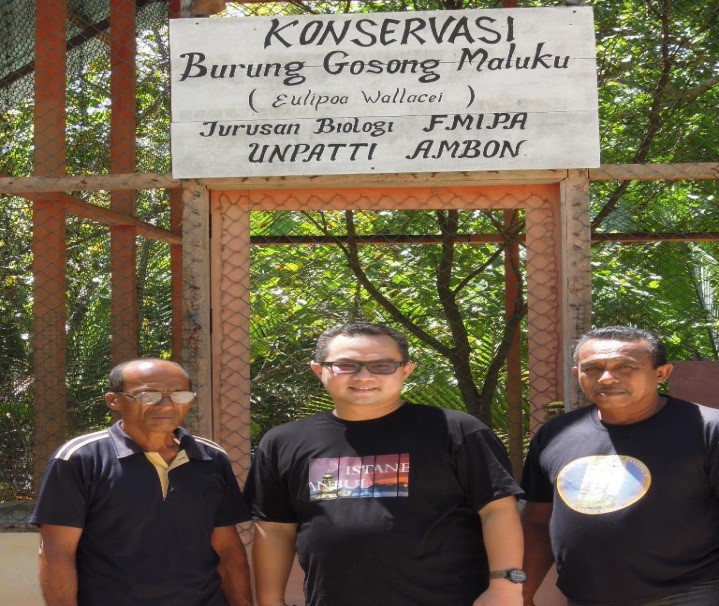
Figure 4: Gosong Bird Conservation
Fourth, there has been a decline in involvement in kewang that is needed to perform surveillance on resources. Some NGOs and donors have noticed problems of kewang regeneration through education and training.
Fifth, the rise of awareness of kewang in empowering sasi laut. Their experience in dealing with outside parties (NGOs, universities and donors) has encouraged kewang empowerment. Kewang of Negeri Haruku have established a foundation to empower kewang in Maluku — the Foundation of Haru-Ukui Kalesang — in terms of coordinating the implementation of inter-kewang of sasi laut in Haruku Island. Through this foundation, the kewang in Haruku Island have facilitated some kewang leaders from other villages to attend national seminars on coastal conservation and empowerment of indigenous people (Figure 3).
Recently sasi laut has been developed by expanding the objects of conservation, including: mangrove ecosystems, the gosong bird (Eulipoa wallacei), turtles, and other coastal resources (Figure 4). In addition, sasi luat is supporting marine tourism through a sasi laut festival in Haruku Village (Figure 5). Gender discourse has also been adopted through the representation of women in the local police corps, kewang. This was facilitated through the efforts made by such external parties as NGOs, donor agencies, and universities.
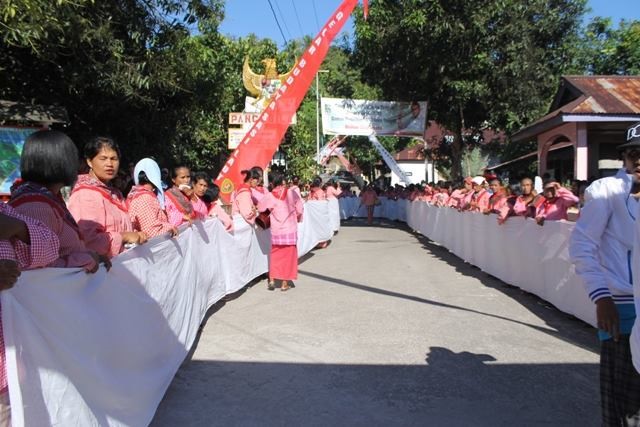
Figure 5: Sasi Laut Festival of Haruku Village
In terms of legislation, the practice of local wisdom in Indonesia, such as sasi laut, has been recognized by the state through two laws and regulations, namely: Act no. 06 Year 2014 (on Village) as well Act no. 23 Year 2014 (on Regional Government) as a replacement of Act no. 32 Year 2004. Sectorally, sasi laut has received recognition from three laws and regulations namely; (i) Act no. 31 Year 2004 amended by Act no. 45 year 2009, on Fisheries; (ii) Act no. 27 Year 2007 amended by Law no. 1 year 2014, on Management of Coastal Areas and Small Islands, and (iii) Act no. 32 Year 2014, on Marine. Political and natural resource governance changes coupled with the strengthening of marine conservation discourse in Indonesia make sasi laut more effective for coastal area protection and resources therein.
The strengthening of sasi laut practices in Maluku is able to answer the challenges of sustainability in the local system, particularly the challenges with implementing Traditional Ecological Knowledge, amid global efforts to develop marine conservation networks. Therefore, the authority of sasi laut management must be responsive to the dynamics of the political system, economy, law, governance, science and technology. That is, the transformation of sasi laut should be aimed at strengthening the capacity of human and institutional resources that are adaptive and responsive to external changes.
References
Statistic of Central Maluku. 2013 Haruku Island in Figures. Central Maluku.
Harkes I and Novaczek I. 2000. Institutional resilience of sasi laut, a fisheries management system in Indonesia. Paper for the 8th Biennial conference of the International Association for the Study of Common Property (IASCP). Indiana University, Bloomington, Indiana.
Mony, A. 2015. Ekologi Politik Pengelolaan Sumberdaya Pesisir: Studi Kasus Relasi Kuasa Pengelolaan Sasi Laut di Pulau Haruku. Tesis. IPB. Bogor
Harkes, I. 1998. An Institutional Analysis of Sasi Laut, A Fisheries Management System In Indonesia. Proceedings of the International Workshop on Fisheries Co-management.
Acknowledgements
Our gratitude is expressed to the community of Haruku Village that has assisted us a lot in collecting data for this research. We would like to acknowledge the support of CCRN, especially Anthony Charles.
Photo credit: Arif Satria and Paul Noris



